What Is a Moving Charge?
A moving charge is an informal way of referring to a charged object changing its position relative to a particular observer. Moving charges differ markedly from stationary ones in that they generate magnetic fields. Since an object can be moving relative to one observer while remaining stationary relative to another, it is possible for different observers to measure different values for the same magnetic field. This observation was one motivation leading Albert Einstein to formulate his special theory of relativity in 1905.
Electric current is a common example of moving charge. When a wire is connected to a battery, the electric field maintained by the battery naturally causes electrons in the wire to move. While electrons are responsible for carrying charge along the wires, larger ions move charge inside the battery. Negative ions move from the positive terminal of a battery to its negative terminal, and positive ions move in the opposite direction. In this manner a battery acts like a pump pushing current around a circuit.

The motion of charges in the circuit generates a magnetic field. Though schoolchildren are often given the impression that the power of an electric circuit lies in the motion of the electrons in the wire, the usefulness of a circuit in all but the most basic applications is found in the electromagnetic fields produced. Modern technology utilizes these fields in myriad ways, most notably to power electromagnets critical to the operation of electric motors.
Moving charges are not only the cause of magnetic fields but they are also affected by them. A magnetic field causes a moving charge to curve and the greater its speed, the more force the magnetic field exerts on the moving charge. In this way, current in one circuit can influence current in another. Transformers use this effect, utilizing the current in one wire to generate a different current in another. Electric power plants use a variation of this idea to generate electricity.
Electrically-charged particles exert force on one another, so work is required to move one relative to another even in the absence of magnetic fields. The work required to assemble a collection of charges equals the electrical energy of the system. Two positively-charged objects repel one another, and the effort required to push them toward one another can be likened to the energy required to compress a spring. A battery can be qualitatively understood as a pair of such springs, and chemical reactions inside the battery cause charges of like sign to bunch up at both ends.
AS FEATURED ON:
AS FEATURED ON:











Discuss this Article
Post your comments